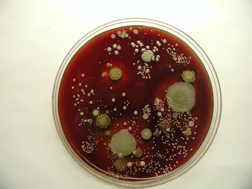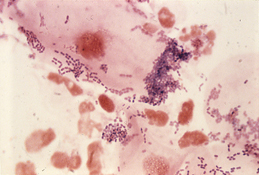 |
An agar plate showing a mixture of microbes growing after exposure to a dirty hand. |
UNMC microbiologist Pete Iwen, Ph.D., works daily with bacteria and viruses and is an expert in public health and disease prevention. Though there’s generally no harm in reusing your own water bottle, not washing it in between refills promotes microbial growth, he said. You’re not likely, however, to get anything harmful from your own microbes.
“If it’s my bottle, my germs, I probably would not be all that paranoid about reusing the bottle,” Dr. Iwen said. “The main issue occurs when sharing bottles. Microbes present in my mouth may be harmful to others.”
The risk for ingesting harmful bacteria increases dramatically if you share your bottle, he said.
 |
An agar plate showing a variety of microbes growing after exposure to contents from the mouth of a healthy person. |
Recent outbreaks of norovirus – an intestinal virus – are an example of how the environment plays a role in microbial transmission. Water bottles could easily be associated with transmission of this agent, Dr. Iwen said.
Reusing water bottles over and over without washing them is like using a coffee cup or eating utensil that hasn’t been washed, he said. “When you drink from a container, some saliva is backwashed into the liquid in the container,” he said. “Saliva provides not only the microorganisms for transmission but also acts as a nutrient for the organisms to multiply.”
Most water bottles were designed with thin plastic walls and a small narrow neck that makes them difficult to clean, he said. For those destined to reuse bottles, Dr. Iwen suggests periodically washing the containers with hot, soapy water.
 |
A microscopic image of saliva from a healthy person showing an assortment of bacterial cells. |
“Bacteria and viruses are all over. The key is to keep the bad organisms out and the good microbes at a level that will not cause you to become infected.”